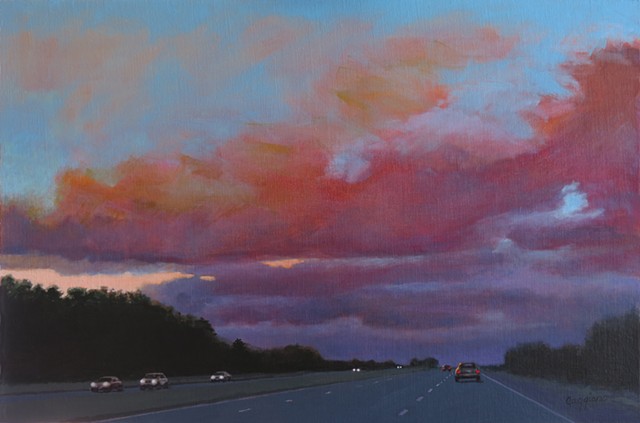
Hofstra University Museum’s current exhibition in Emily Lowe Gallery, “Over the River: Transforming Long Island,” offers an in depth look at the roads and bridges that connect Long Island to New York City and their environmental effect on the land.
The exhibition ranges in style and variety from Robert Bruce Crane’s “plein air” oil painting of a traditional 19th century pastoral scene on Long Island to Andy Warhol’s use of intense color and simple lines in his mirrored twin prints of the Brooklyn Bridge.
The exhibit is divided into two main sections: the routes and infrastructure connecting Long Island to New York City and the impact that this development has had on the landscape of Long Island.
The first section, which focuses on bridge and roadway connections, contains a juxtaposition of traditional and modern. One might think that this would create discord, but somehow this mix of old and new lends itself to a cohesive image of Long Island’s developing transportation routes at the time. Black and white photos depicting the construction of the Long Island Railroad and development plans for state parks and parkways are placed side by side with pop art and abstract paintings of New York’s bridges. Somehow these opposing images all seem to work together beautifully.
One particularly striking piece that expertly melded the muted color palette and careful brushstrokes of the past with the unique perspective of the present was Antonio Masi’s “Going/Coming-Queensboro Bridge.” His watercolor shows the complex and geometric nature of the underside of the bridge, thus giving the audience a different point of view.
The second section of the exhibit delves further into the issue of sustainability and the negative environmental impact of these developing man-made connections.
Perhaps one of the most notable images in this gallery is Margery Caggiano’s “No Exit.” The acrylic painting depicts the simple beauty of a sunset with a dramatic use of color that speaks to the majesty and awesomeness of nature. However, upon closer inspection, the foreground reveals the congested Long Island Expressway. This contrast between beauty and unpleasantness emphasizes the impact that man has had on nature throughout the years.
Another interesting aspect of the sustainability portion of the exhibit is the way in which suburban development that resulted from the construction of these new roadways and bridges was depicted. A black and white aerial photograph shows Levittown, New York, where houses are seemingly copied and pasted one after the other into seemingly endless adjacent lots. Advertising brochures from the 1950s of new housing complexes based on the Levittown model are also on display.
“Over the River: Transforming Long Island” is not only a beautiful lesson in history, but also a warning of what could come in the future if we are not cognizant of our natural surroundings. The exhibit will run through Dec. 16 and is open from 11 a.m. to 4 p.m. Tuesday through Friday and noon to 4 p.m. on Saturday and Sunday at the Emily Lowe Gallery on South Campus.
